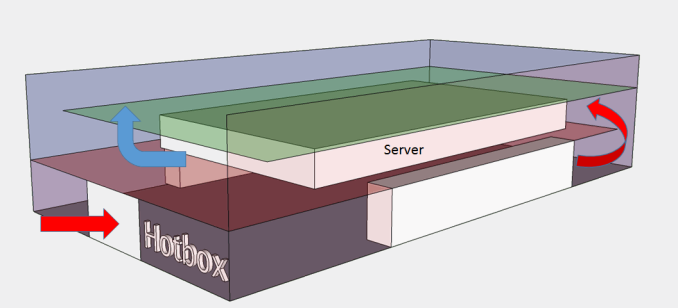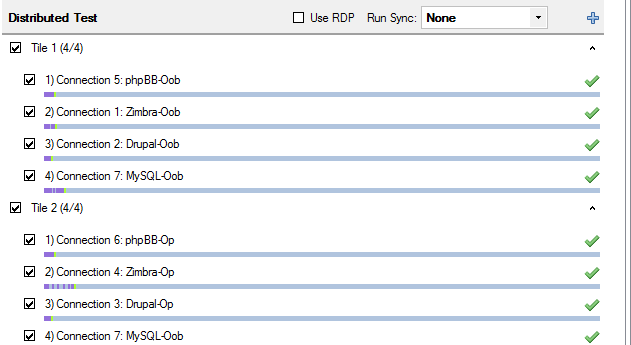Free Cooling: the Server Side of the Story
by Johan De Gelas on February 11, 2014 7:00 AM EST- Posted in
- Cloud Computing
- IT Computing
- Intel
- Xeon
- Ivy Bridge EP
- Supermicro
How We Tested
To determine the optimal point between data center temperature and system cooling performance, we created a controlled temperature testing environment, called a "HotBox". Basically, we placed a server inside an insulated box. The box consists of two main layers: at the bottom is the air inlet where a heating element is placed. The hot air is blown inside the box and is then sucked into the front of the server on the second layer. This way we can simulate that inlet air comes from below, as in most data centers. Inlet and outlet are separated and insulated from each other, simulating the hot and cold aisles. Two thermistors measure the temperature of the inlet, one on the right and on the left, just behind the front panel.
Just behind the motherboard, close to back of the server, a pair of thermistors monitors the outlet temperature. And we'd like to thank Wannes De Smet who designed the hotbox!
The servers is fed by a standard European 230V (16 Amps max.) power line. We use the Racktivity ES1008 Energy Switch PDU to measure power consumption. Measurement circuits of most PDUs assume that the incoming AC is a perfect sine wave, but it never is. However, the Rackitivity PDU measures true RMS current and voltage at a very high sample rate: up to 20,000 measurements per second for the complete PDU.
Datamining on Hardware
Building the "Hotbox" was one thing; getting all the necessary data on the other hand is a serious challenge. A home-made PCB collects the data of the thermistors. Our vApus stress testing software interfaces with ESXi to collect hardware usage counters and temperatures; fan speeds are collected from the BMC; and power numbers from the Racktivity PDU. This is all done while placing a realistic load on the ESXi virtual machines. The excellent programming work of Dieter of the Sizing Servers Lab resulted in a large amount of data in our Excel sheets.
To put a realistic load on the machine we use our own real-life load generator called vApus. With vApus we capture real user interaction with a website, add some parameters that can be randomized, and then replay that log a number of times.
The workload consists of four VMs:
- Drupal LAMP VM running sizingservers.be website
- Zimbra 8 VM
- phpBB LAMP VM running clone of real website
- OLAP (news aggregator database)
The Drupal site gets regular site visitors mixed with the posting of new blog entries and sending email, resulting in a moderate system load. The Zimbra load is disk-intensive, consisting of users creating and sending emails, replying, creating appointments, tasks and contacts. The phpBB workload has a moderate CPU and network load, viewing and creating forum threads with rich content. Finally, the OLAP workload is based on queries from a news aggregator and is mostly CPU bound. These four VMS form one Tile (similar to VmMark "tiles"). We ran two tiles in each test, resulting in a load of 10% to 80%.












48 Comments
View All Comments
ShieTar - Tuesday, February 11, 2014 - link
I think you oversimplify if you just judge the efficiency of the cooling method by the heat capacity of the medium. The medium is not a heat-battery that only absorbs the heat, it is also moved in order to transport energy. And moving air is much easier and much more efficient than moving water.So I think in the case of Finland the driving fact is that they will get Air temperatures of up to 30°C in some summers, but the water temperature at the bottom regions of the gulf of Finland stays below 4°C throughout the year. If you would consider a data center near the river Nile, which is usually just 5°C below air temperature, and frequently warmer than the air at night, then your efficiency equation would look entirely different.
Naturally, building the center in Finland instead of Egypt in the first place is a pretty good decision considering cooling efficiency.
icrf - Tuesday, February 11, 2014 - link
Isn't moving water significantly more efficient than moving air because a significant amount of energy when trying to move air goes to compressing it rather than moving it, where water is largely incompressible?ShieTar - Thursday, February 13, 2014 - link
For the initial acceleration this might be an effect, though energy used for compression isn't necessary lost, as the pressure difference will decay via motion of the air again (but maybe not in the preferred direction. But if you look into the entire equation for a cooling system, the hard part is not getting the medium accelerated, but to keep it moving against the resistance of the coolers, tubes and radiators. And water has much stronger interactions with any reasonably used material (metal, mostly) than air. And you usually run water through smaller and longer tubes than air, which can quickly be moved from the electronics case to a large air vent. Also the viscosity of water itself is significantly higher than that of air, specifically if we are talking about cool water not to far above the freezing point of water, i.e. 5°C to 10°C.easp - Saturday, February 15, 2014 - link
Below Mach 0.3, air flows can be treated as incompressible. I doubt bulk movement of air in datacenters hits 200+ Mphjuhatus - Tuesday, February 11, 2014 - link
Sir, I can assure you the Nordic Sea hits ~20°C in the summers. But still that tempereture is good enough for cooling.In Helsinki they are now collecting the excess heat from data center to warm up the houses in the city area. So that too should be considered. I think many countries could use some "free" heating.
Penti - Tuesday, February 11, 2014 - link
Surface temp does, but below the surface it's cooler. Even in small lakes and rivers, otherwise our drinking water would be unusable and 25°C out of the tap. You would get legionella and stuff then. In Sweden the water is not allowed to be or not considered to be usable over 20 degrees at the inlet or out of the tap for that matter. Lakes, rivers and oceans could keep 2-15°C at the inlet year around here in Scandinavia if the inlet is appropriately placed. Certainly good enough if you allow temps over the old 20-22°C.Guspaz - Tuesday, February 11, 2014 - link
OVH's datacentre here in Montreal cools using a centralized watercooling system and relies on convection to remove the heat from the server stacks, IIRC. They claim a PUE of 1.09iwod - Tuesday, February 11, 2014 - link
Exactly what i was about to post. Why Facebook, Microsoft and even Google didn't manage to outpace them. PUE 1.09 is still as far as i know an Industry record. Correct me if i am wrong.I wonder if they could get it down to 1.05
Flunk - Tuesday, February 11, 2014 - link
This entire idea seems so obvious it's surprising they haven't been doing this the whole time. Oh well, it's hard to beat an idea that cheap and efficient.drexnx - Tuesday, February 11, 2014 - link
there's a lot of work being done on the UPS side of the power consumption coin too - FB uses both Delta DC UPS' that power their equipment directly at DC from the batteries instead of the wasteful invert to 480vac three phase, then rectify again back at the server PSU level, and Eaton equipment with ESS that bypasses the UPS until there's an actual power loss (for about a 10% efficiency pickup when running on mains power)